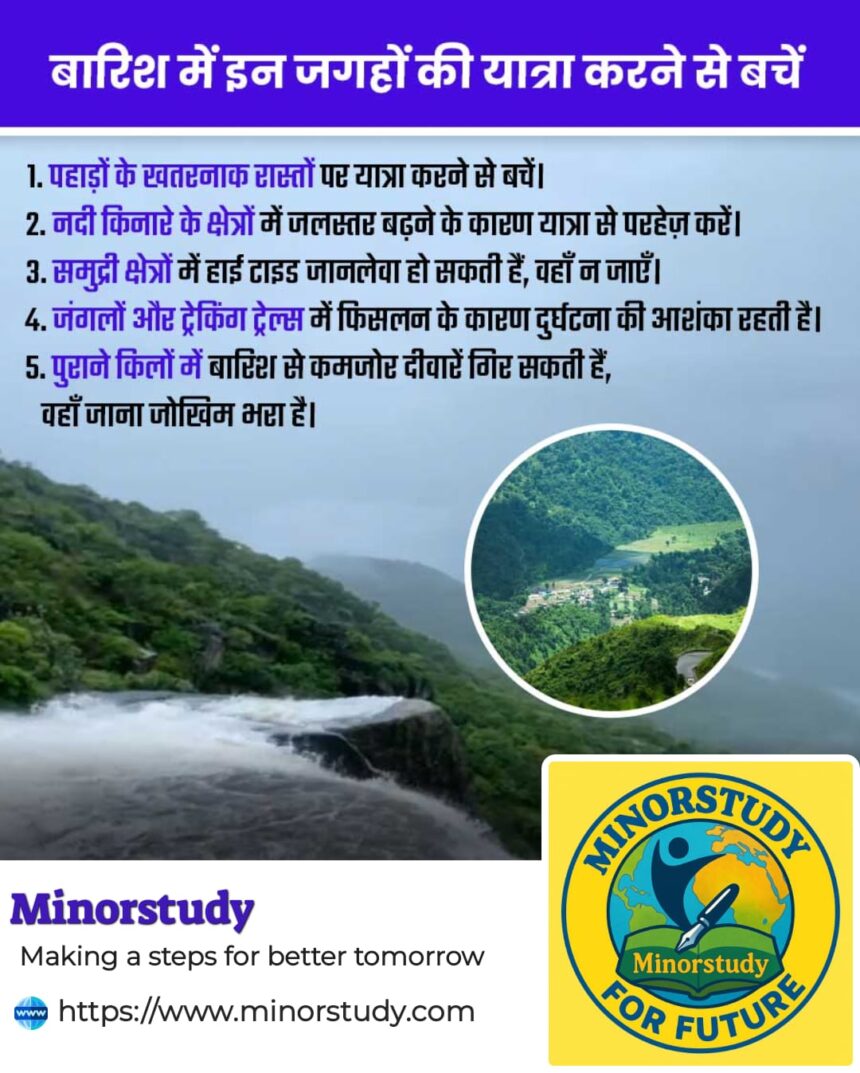🌧️ 5 Dangerous Places to Avoid in Monsoon – Save Your Life with These Critical Travel Tips
Monsoon brings beauty, freshness, and relief—but it also brings hidden dangers, especially when it comes to traveling. While the romantic rains tempt many of us to explore nature, it’s crucial to be aware of places that turn hazardous during this season.
- 📖 History: Monsoon & Travel – A Mixed Relationship
- 🗓️ Timeline of Major Monsoon Travel Hazards in India
- ⚠️ 5 Most Dangerous Places to Avoid During Monsoon
- 1. 🏔️ Narrow Mountain Roads
- 2. 🌊 Riverbanks and Low-Lying Flood-Prone Areas
- 3. 🌐 Coastal Areas with High Tides
- 4. 🌳 Jungles and Trekking Trails
- 5. 🏰 Ancient Forts and Ruins
- 📚 Important Facts to Know
- ❓ FAQs About Monsoon Travel Risks
- Q1. Can we travel to hill stations in monsoon?
- Q2. Which months are most dangerous for monsoon travel in India?
- Q3. Is trekking safe in the rainy season?
- Q4. Is coastal travel dangerous during monsoons?
- Q5. How to check if a place is safe to visit in monsoon?
- 🎯 Significance: Why Should We Be Cautious?
- 🎉 Wishing Message for Monsoon Travelers
- 🧠 Important in Our Life
- 🚫 Observance: How to Stay Cautious
- 📌 Key Takeaways
- 🧭 Daily Life Impacts
- ✅ Conclusion: Adventure Can Wait, But Life Can’t Be Rewound
This article walks you through the history, reasons, risks, facts, FAQs, significance, and life-saving tips related to places you must avoid during the rainy season. Whether you’re a solo traveler, a family person, or an adventure lover, this detailed guide will help you make wise decisions during monsoons.
📖 History: Monsoon & Travel – A Mixed Relationship
In Indian culture, monsoon holds emotional and agricultural significance. However, for centuries, certain places have remained notoriously unsafe during this season due to natural calamities, poor infrastructure, and geological instability.
From the 1970 Uttarakhand landslides to the 2013 Kedarnath tragedy, monsoons have reminded us that nature is not to be underestimated.
🗓️ Timeline of Major Monsoon Travel Hazards in India
| Year | Event | Area Affected |
|---|---|---|
| 1970 | Cloudburst | Tehri-Garhwal, Uttarakhand |
| 2005 | Mumbai floods | Mumbai, Maharashtra |
| 2013 | Kedarnath disaster | Uttarakhand |
| 2018 | Kerala floods | Kerala |
| 2021 | Mahad Landslide | Maharashtra |
| 2023 | Himachal floods & landslides | Himachal Pradesh |
⚠️ 5 Most Dangerous Places to Avoid During Monsoon
1. 🏔️ Narrow Mountain Roads
Why Dangerous:
Landslides are frequent
Slippery roads cause vehicle skidding
Rockfalls and road closures are common
Avoid:
Manali–Leh Highway
NH-707 in Himachal
Roads to remote hill stations
2. 🌊 Riverbanks and Low-Lying Flood-Prone Areas
Why Dangerous:
Sudden rise in water level due to upstream rain
Risk of being swept away
Stagnant water invites diseases
Avoid:
Ganga, Yamuna banks during peak monsoon
Brahmaputra basin in Assam
Bihar’s flood zones
3. 🌐 Coastal Areas with High Tides
Why Dangerous:
Cyclonic activity
Storm surges and high tides
Slippery rocks, jellyfish stings, drowning risks
Avoid:
Goa’s rocky beaches during heavy rain
Konkan coast during tide alerts
Odisha coast during cyclones
4. 🌳 Jungles and Trekking Trails
Why Dangerous:
Slippery mud paths, leeches, snakes
Flash floods in forest streams
Weak mobile network; harder to call for help
Avoid:
Sahyadri treks like Rajmachi, Harishchandragad
Jungle trails in Jim Corbett or Bandipur
Dudhsagar waterfall trek
5. 🏰 Ancient Forts and Ruins
Why Dangerous:
Rainwater weakens old stone and mud structures
Risk of collapsing walls
Moss-covered stairs can be dangerously slippery
Avoid:
Raigad, Sinhagad, Chittorgarh during monsoon
Forts with no active maintenance
📚 Important Facts to Know
Over 60% of monsoon accidents in India happen due to road instability or natural slides.
Every year, thousands of tourists are stranded due to sudden weather shifts during monsoons.
The Indian Meteorological Department (IMD) issues regular weather alerts and travel advisories—always check before you plan.
Several travel insurance companies exclude monsoon-related damage, making it even riskier.
Despite risks, over-tourism continues in popular rainy spots due to lack of awareness.
❓ FAQs About Monsoon Travel Risks
Q1. Can we travel to hill stations in monsoon?
You can, but it’s not recommended unless the weather is clear and roads are confirmed safe. Prefer post-monsoon or pre-monsoon for hilly regions.
Q2. Which months are most dangerous for monsoon travel in India?
July to mid-September is the peak monsoon period when travel is most risky.
Q3. Is trekking safe in the rainy season?
No. Trekking during monsoon increases the risk of injuries, wild animal encounters, and isolation due to landslides.
Q4. Is coastal travel dangerous during monsoons?
Yes, especially if cyclones or high tide alerts are issued. Avoid deep-sea sports and swimming during rains.
Q5. How to check if a place is safe to visit in monsoon?
Follow IMD weather alerts, local news, and official tourism department advisories.
🎯 Significance: Why Should We Be Cautious?
Saves Lives: Avoiding danger zones protects you and your loved ones.
Supports Emergency Services: Fewer rescue operations are needed when tourists follow guidelines.
Preserves Infrastructure: Lesser load on fragile paths and mountain roads.
Sets Social Example: Being cautious helps spread awareness in society.
🎉 Wishing Message for Monsoon Travelers
🌧️ “Wish you a safe, scenic, and smart monsoon season. Let your journey be joyful but never at the cost of your safety. Travel smart – return safe!” ☔
🧠 Important in Our Life
Staying safe during monsoon is not just about avoiding accidents—it’s also about:
Making informed decisions
Being responsible travelers
Spreading awareness among peers
Respecting nature’s power
Monsoons teach us that while nature is beautiful, it is also unpredictable. A wise traveler knows where to stop, when to wait, and when to say no.
🚫 Observance: How to Stay Cautious
Subscribe to local weather alerts
Travel with a basic emergency kit
Avoid solo trips during storms
Don’t camp near riverbeds or landslide-prone areas
Respect barricades and red zone warnings
📌 Key Takeaways
Avoid mountain passes, riverbanks, coastal zones, jungles, and forts in monsoon.
Check weather updates daily before and during your trip.
Reschedule your travel if danger signs emerge.
Your safety is more important than adventure selfies.
🧭 Daily Life Impacts
Helps families plan safe vacations
Reduces road accident rates
Supports eco-tourism by preventing overburdening of fragile areas
Encourages a culture of safety-first among travelers
✅ Conclusion: Adventure Can Wait, But Life Can’t Be Rewound
Monsoon is a magical time—but not every place is meant to be explored during heavy rains. With increasing climate volatility, being aware and alert can literally save lives.
Don’t let the excitement of Instagram-worthy views cost you your well-being. Safety is the real adventure—and the true memory lies in returning home safely, with stories that inspire, not warn.
So, this monsoon, let’s travel mindfully. Avoid these 5 dangerous zones and explore greener, safer alternatives with wisdom and care. 🌿









Just want to say your article is as astonishing. The clarity on your post is simply excellent and i could suppose you’re an expert on this subject. Well together with your permission let me to take hold of your RSS feed to keep up to date with drawing close post. Thank you a million and please keep up the enjoyable work.
certainly like your web-site but you need to test the spelling on several of your posts. Several of them are rife with spelling issues and I find it very troublesome to tell the reality nevertheless I?¦ll surely come back again.
I¦ve been exploring for a little bit for any high quality articles or blog posts in this sort of house . Exploring in Yahoo I at last stumbled upon this website. Studying this info So i am glad to express that I have an incredibly good uncanny feeling I came upon just what I needed. I such a lot undoubtedly will make sure to do not put out of your mind this website and provides it a look regularly.
Great – I should certainly pronounce, impressed with your website. I had no trouble navigating through all the tabs and related info ended up being truly simple to do to access. I recently found what I hoped for before you know it in the least. Quite unusual. Is likely to appreciate it for those who add forums or something, website theme . a tones way for your client to communicate. Excellent task..